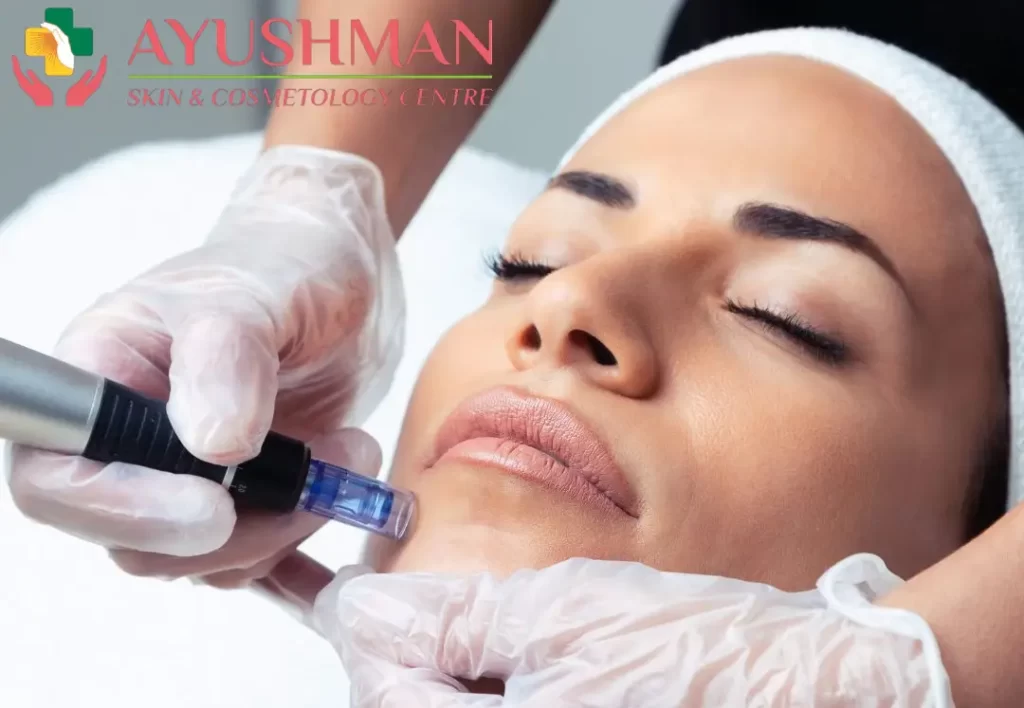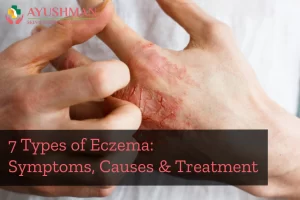So, you know how sometimes your skin starts showing signs of aging, like acne, scars, pores acting up, or wrinkles? Well, it happens for various reasons, not just getting older. Sun exposure and hormonal stuff can mess with your skin too. But hey, if you find that your skin is looking older than expected, there is this great microneedling treatment in Dwarka that can help.
Here’s the deal: microneedling uses tiny needles to make little punctures in your skin. Sounds scary, right? But it’s not that bad, I promise. These tiny needle pricks actually make your skin produce more collagen, which is a great way to fix up damaged skin. It not only tackles the aging signs but also makes your skin healthier, firmer, and smoother. And the best part? Despite the needles, it’s not as painful as you might think, and you won’t need much downtime.
Table of Contents
ToggleWhat Is Microneeding?
Microneedling is a gentle skin procedure that involves your healthcare provider using fine needles to create small punctures in the outer layer of your skin. These tiny injuries kickstart your skin’s natural healing process, prompting it to generate more collagen and elastin. These proteins play a key role in maintaining the firmness and smoothness of your skin.
While many people opt for microneedling on their face, it’s versatile enough to be performed on various areas like the legs, back, neck, or anywhere you’ve noticed signs of damaged or aging skin. Keep in mind that achieving your desired results may require multiple treatment sessions.
Who Should Opt For Microneedling?
Microneedling serves both cosmetic and medical purposes. It might be something you consider if you’re bothered by:
- Enlarged pores.
- Fine lines or wrinkles.
- Loose or crepey (thin and wrinkled) skin.
- Mild scars, especially from acne or burns.
- Skin discoloration or uneven tone.
- Stretch marks.
Additionally, the procedure is beneficial for individuals with certain medical conditions:
- Alopecia areata (hair loss caused by an autoimmune disease).
- Hyperhidrosis (excessive sweating).
In some instances, healthcare providers use microneedling as a method to administer drugs or vaccines directly into the skin. The microneedles may be part of a patch that individuals can apply themselves, offering an alternative to traditional injections administered by healthcare providers.
Who Should Avoid Microneedling?
Before undergoing microneedling, it’s crucial to consult your healthcare provider if you:
- Have acne or are taking acne medication.
- Have blood disorders or are on anticoagulants (medications preventing blood clots).
- Are undergoing chemotherapy or radiation therapy for cancer.
- Experience frequent skin rashes (contact dermatitis) or cold sores.
- Tend to form keloids (hard, raised scars).
- Possess moles, freckles, skin tags, or other growths that change in size or shape or bleed.
What Happens Before Microneedling?
Before undergoing microneedling, you’ll engage in a consultation with a healthcare provider, which could be a plastic surgeon, dermatologist, or aesthetician, all well-versed in microneedling techniques. It’s crucial to ensure that the person performing the procedure has sufficient experience.
During this consultation, your healthcare provider will carefully assess your skin, delve into your health history, and discuss your objectives for the microneedling treatment in Dwarka. They may also capture photos of the targeted area, providing a visual reference for comparing your skin before and after the procedure.
This is an opportune moment to address any queries you might have about microneedling, such as:
- What are the potential risks or side effects?
- Does microneedling cause discomfort?
- How soon can I expect to see results?
- Is there any downtime following the procedure?
- Will additional treatments be necessary?
Approximately a month before the scheduled treatment, your healthcare provider might recommend applying vitamin A or C cream to your skin. These creams play a role in initiating the collagen production process, contributing to the overall effectiveness of the microneedling treatment in Dwarka.
What Happens During Microneedling?
The process begins with your healthcare provider cleansing your skin and applying a numbing cream or ointment, such as lidocaine gel. This is typically done around 30 to 45 minutes before the actual procedure to allow the ointment to take effect.
Following the numbing application, your healthcare provider utilizes either a hand-held roller or an electric tool to create micro-wounds in your skin. The roller is equipped with tiny needles and is rolled slowly and gently across your skin. In the case of the electric device, needles pulse up and down to puncture the skin, with the option to adjust the needle length. Longer needles penetrate deeper into the skin, which might be necessary for addressing deep scars or pockmarks from acne. Needle lengths can vary from 0.5 millimeters to 2 millimeters.
Once microneedling begins, you may experience warmth or a scratching sensation on your face. Some individuals may feel mild discomfort, especially in areas near bony structures like cheekbones. Deep microneedling could result in minor bleeding.
The duration of a microneedling session can range from 15 minutes to a few hours, depending on the size of the treated area.
What Happens After Microneedling?
Microneedling is typically an outpatient procedure, allowing you to return home once it’s completed. Expect your skin to appear red and slightly swollen for about five days. Using an ice pack can be beneficial in alleviating irritation and discomfort during this period. While many individuals can resume wearing makeup the day after the procedure, it’s advisable to avoid sun exposure until your skin has fully healed.
Microneedling Benefits
Microneedling emerges as a versatile solution addressing various concerns, including:
- Acne
- Hair loss (alopecia)
- Hyperpigmentation
- Enlarged pores
- Diminished skin elasticity
- Scarring
- Stretch marks
- Sun damage
- Fine lines and wrinkles
Not only does microneedling offer a broad spectrum of benefits, but it also presents a more cost-effective alternative compared to laser treatments, which can be up to four times as expensive. Particularly advantageous for individuals with darker skin tones, microneedling avoids the use of heat, a factor in laser treatments that may impact skin pigmentation or color. Consult with your dermatologist to determine the optimal solution for your skin concerns, aligning with both your skincare needs and budget.
What Are The Risks Of Microneedling?
While the medical community generally recognizes microneedling as a safe and effective procedure, it’s essential to be aware of potential risks.
The primary risk involves post-procedure skin irritation. Additional side effects may include:
- Swelling
- Discomfort at the treatment site
- Redness
- Bruising
- Dryness
- Flaking of the skin
Although bleeding is a rare occurrence with microneedling, it may be more likely after a deeper treatment. Individuals with bleeding disorders or those taking blood-thinning medications should inform their doctor, as this could increase the risk of bleeding.
To minimize risks, it is advisable to consult with a dermatologist or a medical skincare professional experienced in these procedures before undergoing microneedling.
In conclusion, microneedling is a minimally invasive procedure designed to enhance the overall appearance of your skin. If you’re grappling with concerns like acne scars, stretch marks, or other skin imperfections, microneedling could be the solution you’ve been seeking.
At Ayushman Skin & Cosmetology Centre, we take pride in offering the best microneedling treatment in Dwarka. Our outpatient procedure ensures a safe experience for individuals looking to revitalize their skin. To achieve your desired results, multiple treatments may be required over several months. Consult with our experienced team to embark on your journey towards radiant and rejuvenated skin.
FAQs (Microneedling)
Q: What skin concerns can microneedling address?
A: Microneedling is effective in treating various skin issues, including acne scars, fine lines, wrinkles, enlarged pores, stretch marks, and uneven skin tone.
Q: Is microneedling a painful procedure?
A: While some patients may experience mild discomfort, a topical numbing cream is usually applied before the treatment to minimize any potential pain. Most individuals find the procedure tolerable.
Q: How long does a microneedling session typically last?
A: The duration of a microneedling session can vary but generally ranges from 15 minutes to a few hours, depending on the size of the treated area.
Q: How many sessions are needed for noticeable results?
A: Multiple sessions are often recommended for optimal results. The number of sessions required depends on your skin concerns and the desired outcome. Your healthcare provider can provide a personalized treatment plan during the consultation.
Q: What is the downtime after microneedling?
A: Patients may experience redness and mild swelling for a few days after the procedure. However, most individuals can resume their regular activities within a short period. The downtime varies depending on the depth of the microneedling treatment.







